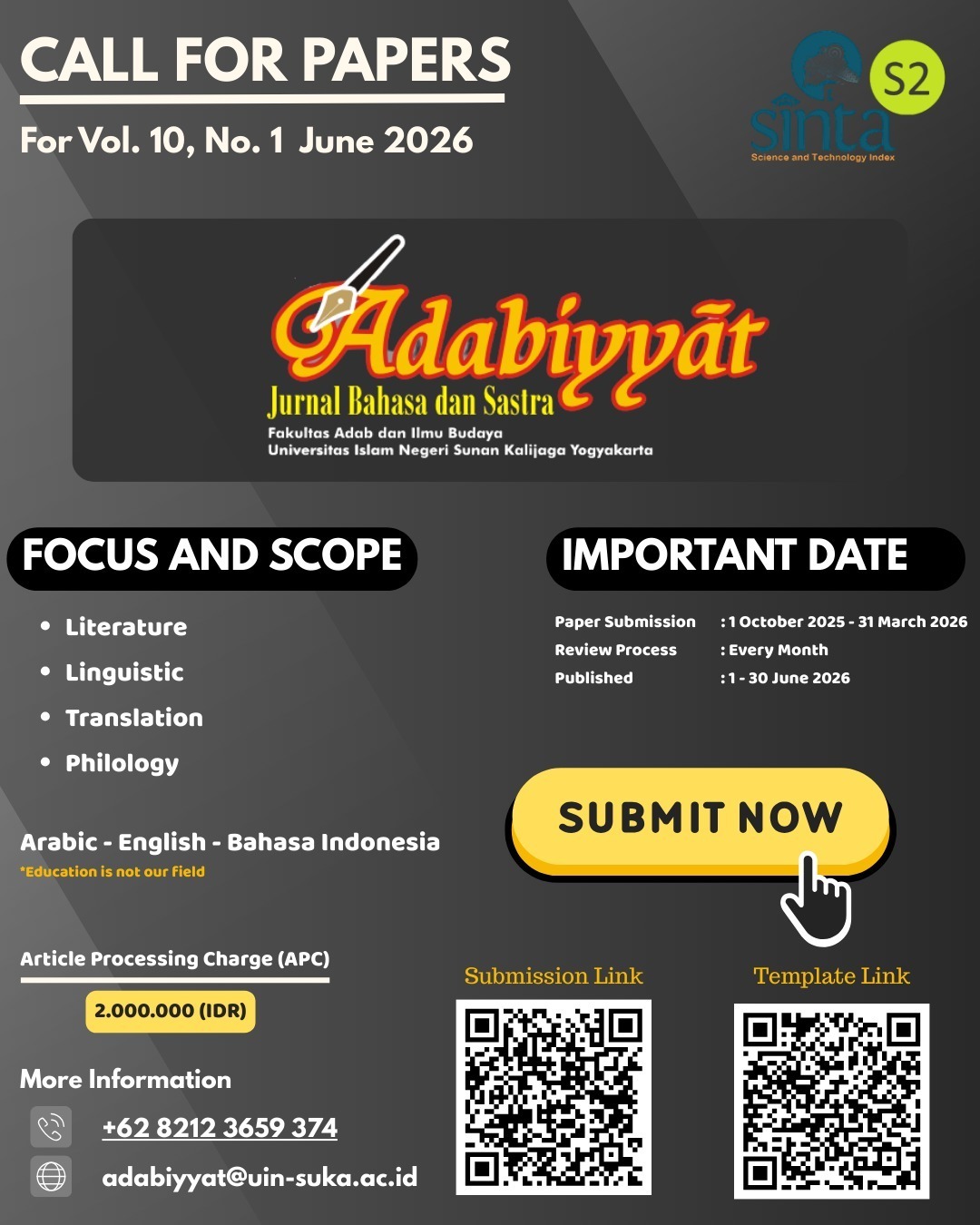SESENGGAK DALAM BAHASA SASAK: CITRAAN METAFORIS DAN SIGNIFIKANSINYA
DOI:
https://doi.org/10.14421/ajbs.2010.09104Abstract
The aims of this research are to describe the metaphorical image in sêsênggak (Sasak proverbs) which is based on the types of reference as the target domain (tenor) and source domain (vehicle); and to uncover the meaning or significance. The data are collected through participant observation method and in-depth interview with key informants. The results show, on one hand, that the sociocultural background of the Sasak community gives the most dominant contribution in sêsênggak’s lexicon (language). On the other, that socio-cultural background has much mpression on the various humanitarian issues involving sêsênggak, which is created to control (directive-prohibitive) and to evaluate the attitude or behavior of a person or a certain group of people. On that ground, sêsênggak was born from some unique mixtures of the natural environment and the socio-cultural organization of thoughts, opinions, memories, senses, experiences, knowledge, imaginations, creativities, sensitivities, intelligences, as well as consciousness, which are based on the rules, the laws, and the societal structures. These mixtures become a united, coherent, rational, and organized expression in the framework of language and conscience.
Downloads
References
Campbell, Lyle. 2001. “The History of Linguistics”, dalam The Handbook of Linguistics. Massachusetts: Blackwell Publishers Inc.
Cormac, Earl R. Mac. 1985. A Cognitive Theory of Metaphor. Massachusetts: The MIT Press.
Crystal, David. 1992. The Cambridge Encyclopedia of Language. Cambridge: Cambridge University Press.
Danandjaja, James. 1984. Folklor Indonesia: Ilmu Gosip, Dongeng, dan Lain-lain. Jakarta: PT Grafiti Pers.
Kridalaksana, Harimurti. 2001. Kamus Linguistik. Edisi ketiga. Jakarta: Gramedia Pustaka Utama.
Lyons, John. 1978. Semantics 1. Cambridge: Cambridge University Press.
Mahsun. 2007. Metode Penelitian Bahasa: Tahapan Strategi, Metode, dan Tekniknya. Edisi Revisi. Jakarta: PT Raja Grafindo Persada.
Mahyuni. 2004. “Indirectness pada Masyarakat Sasak: Fenomena Metafor.” Linguistik Indonesia: Jurnal Ilmiah Mansyarakat Lingistik Indonesia, Tahun ke 22, Nomor 1.
Marsono. 1996. “Lokajaya: Suntingan Teks, Terjemahan, Struktur Teks, Analisis Intertekstual dan Semiotik.” Disertasi S-3. Yogyakarta: Universitas Gadjah Mada.
Ratna, Nyoman Kutha. 2005. Sastra dan Cultural Studies: Representasi Fiksi dan Fakta. Yogyakarta: Pustaka Pelajar.
Sampson, Geoffrey. 1980. Schools of Linguistics: Competition and Evolution. London: Hutchinson.
Saeed, John I. 2000. Semantics. Massachusetts: Blackwell Publishers.
Siregar, Bahren Umar. 2005. “Jeruk Kok Minum Jeruk: Gejala Metaforis dan Metotimisasi dalam Bahasa Indonesia.” Linguistik Indonesia: Jurnal Ilmiah Mansyarakat Lingistik Indonesia, Tahun ke 23, Nomor 2.
Spradley, James P. 1997. Metode Etnografi. Yogyakarta: PT Tiara Wacana.
Suhandano. 2004. “Klasifikasi Tumbuh-tumbuhan dalam Bahasa Jawa: Sebuah Kajian Linguistik Antropologis.” Disertasi S-3. Yogyakarta: Sekolah Pascasarjana Universitas Gadjah Mada.
White, Geoffrey M., 1987. “Proverbs and Cultural Models.” Dalam Cultural Models in Language and Thought. Cambridge: Cambridge University Press.
Downloads
Published
Issue
Section
License
- Adabiyyāt: Jurnal Bahasa dan Sastra publishes all articles entirely in full text.
- It is permissible for readers to download and to use it for scientific purposes and scientific dissemination.
- The author can re-publish the article that has been published by the Adabiyyāt: Jurnal Bahasa dan Sastra after obtaining written permission from the editor. This letter can be obtained by submitting a request letter for permission to republish the article to Adabiyyāt: Jurnal Bahasa dan Sastra via email adabiyyat@uin-suka.ac.id. In the second publication, the author is required to include information that the article was firstly published by the Adabiyyāt: Jurnal Bahasa dan Sastra.









